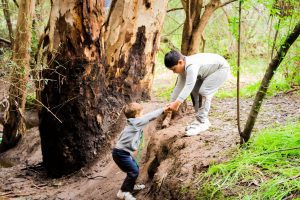“Do you remember that spot? I do. It was right here where I first saw you and your sister and we just started running and laughing.”
“Yeah! I remember! And we’ve been best friends ever since.”
The day that this grand friendship came to be, these younger campers at TimberNook were experiencing a lot of anxiety. Neither child knew anyone else at the program and both were a bit timid to make new connections. Yet, with time and space, they made a choice to be brave and ended up finding an absolute treasure – a best friend. Someone to laugh with and run with in the rain. Someone who speaks your love language and brings out your kindest self.
To see the resilience, growth, and connection amongst children over the course of a few weeks is an observational highlight of my TimberNook journey thus far.
It’s a reminder there’s so much opportunity for growth in the seemingly uncomfortable, yet essential social moments. Like a rainbow after a storm, something exceptional can follow trials and challenges. Its potential is all in how we communicate.
 As a child with extreme anxiety myself, I was fortunate to have a great influence — my third-grade teacher, Mrs. Haulk. I wanted to grow up to be like this woman, who had iguanas, a hip taste in music, Miss Frizzle style hairdos, and the ability to impact a life in such a positive and tremendous way. Basically, the coolest! She was the first person that empowered me to take control of my anxiety. She taught me how to recognize that there are lessons in making mistakes. It was okay to get out of my comfort zone, to communicate & express my feelings openly and freely, and to not let that hold me back from taking on new adventures. Fear was no longer was a road-block, but a catalyst to push me out of my comfort zone.
As a child with extreme anxiety myself, I was fortunate to have a great influence — my third-grade teacher, Mrs. Haulk. I wanted to grow up to be like this woman, who had iguanas, a hip taste in music, Miss Frizzle style hairdos, and the ability to impact a life in such a positive and tremendous way. Basically, the coolest! She was the first person that empowered me to take control of my anxiety. She taught me how to recognize that there are lessons in making mistakes. It was okay to get out of my comfort zone, to communicate & express my feelings openly and freely, and to not let that hold me back from taking on new adventures. Fear was no longer was a road-block, but a catalyst to push me out of my comfort zone.
By age twenty-four, I was a Speech therapy student. I started to observe everyone. How did perception influence relationships? How much do words really matter? What about non-verbal language? Is happiness primarily dependent on our ability to communicate? And if communication matters this much to humanity, why are our classrooms not developmentally appropriate environments to develop these necessary skills?
The average child today doesn’t get enough time and space to play outdoors with other children. And this is profoundly affecting how much practice & opportunity they have with real, authentic face-to-face interactions with others. Without adequate time to develop these skills, it leads to numerous issues including isolation, lack of self-confidence, and fear. We’re seeing the drastic rise of depression, self-harm, and lack of setting healthy boundaries amongst children today.
With nature as the classroom, we see kids (and adults!) overcoming slight social challenges — helping them to further fine-tune their communication skills.
Encoding and decoding messages, forming bonds, listening, practicing empathy, executive functions, and reading nonverbal cues are just some of the skills that are being utilized during outdoor playtime with others.
Through almost every TimberNook experience, children are also either forming a new friendship or strengthening a current one. They laugh and they don’t want to leave. They ask to come back. They thrive and grow academically and emotionally, through the uncomfortable. They get dirty and sometimes and have to get themselves back up. We see resilience. It’s the perfect speech clinic with ample communication to observe.
If we don’t empower our children when they fall or make mistakes…if we’re always there to correct, rather than to guide…then our children won’t be effective communicators and fear will stop them in their tracks from living their life fully.
Instead, we must prioritize time and space (especially with others) in outdoor play opportunities. This must be done on a frequent basis if we expect our children to be able to develop healthy relationships and a strong sense of self. Running in the woods, making a friend. It may seem simple, but we mustn’t underestimate the importance of this basic need.
Resources:
https://www.mdpi.com/1660-4601/19/19/12038
https://news.cornell.edu/stories/2022/03/face-face-interaction-enhances-learning-innovation
https://www.sciencedirect.com/science/article/abs/pii/S1353829214000379
